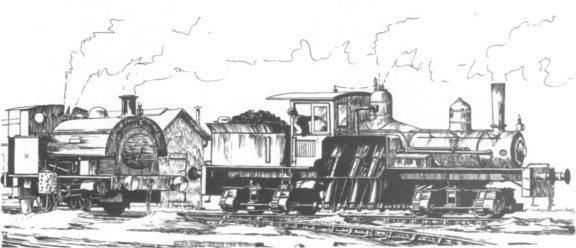
| THE INDUSTRIAL RAILWAY RECORD |
© FEBRUARY 1969 |
THE BILSTON SHAY
S. BARNES
Our Pocket Books are full of tantalising references to exotic and long-departed industrial locomotives, which fire the imagination of every enthusiast. To my mind, however, none more so than the brief entry under Stewarts & Lloyds Ltd, Bilston, Staffs, (Sir Alfred Hickman at the time this article is set), which reads, "LIMA 0−4−4−0G Shay Lima Co Scr. c/12".
Now what images that conjures up! I like to picture the occasion when the engine was first steamed after arrival at Bilston - the driver and fireman rather warily setting about their work; the foreman and perhaps even the Chief Engineer (no less) keeping a stern eye on things, all under the curious gaze of a large crowd of onlookers, including the stiff-collared office staff, drawn from their quill pens and ledgers by this engaging oddity from across the Atlantic, so different in every way from the four-coupled saddle-tanks which until then had had the Bilston sidings to themselves.
Perhaps it was nothing like that at all, but it pleases me to think it was. The Shay would be certain to attract attention with its novel method of operation and its lop-sided aspect (the boiler being offset to the left to accommodate the engine unit on the right hand side). Like all Shays, it would have had three cylinders mounted vertically; power being transmitted via a crankshaft through a flexible lineshaft to bevel gears on the power bogies, both of which had great freedom of movement. Also of interest is that while the left hand cylinder had its steam chest mounted to the left, the other two had theirs to the right. To see this engine on the move with its distinctive motion and rapid exhaust, must have been enthralling to English eyes.
Although all this might lead one to suspect that the Shay was a highly complicated and even delicate unit, it was far from being so.
These locomotives generally worked in atrocious conditions, often achieving considerable longevity: they were an everyday sight on the logging railroads of Americaís West-Coast until very recently. Ephraim Shay, their inventor, was a logging man himself, and knew what he was doing when he went to Lima, of Ohio, with his plans. Over the years, Lima built hundreds of Shays, and Williamette also constructed some to virtually the same design. Climax and Heisler, even Baldwin to a limited extent, also had their own ideas on the subject.
The Pocket Book offers no clue as to the actual identity of the Bilston engine, but a letter published in the July 1965 issue of Railway World written by Herr Dunker of Bremen who had had access to Lima records, states that it was Works No.618, shipped to Sir Alfred Hickman in 1900, and I see no reason to doubt this. He also quotes the running number "1", whereas the Pocket Book implies that the engine was simply called LIMA. I would think this number was almost certainly carried (though Hickmanís engines up to this time had only carried names): the name may have been added later or it might have only been a nickname by which the locomotive was generally referred to.
So there we are - a fascinating story with a lot of gaps in it. We do not know how or why Hickman ever came to acquire such a powerful machine. Surely there was nothing at Bilston which the existing fleet could not handle, and that, I suggest, is quite simply why the Shay lasted only twelve years. Spares might also have been a problem, though a Shay could reputedly run in a condition that would have had any ordinary locomotive stopped immediately.

For my sketch I compared such pictures as I had of Shays to arrive at what seemed to be the standard type of the period - certainly the photographs Iíve seen of engines between Works Nos. 500 and 700 (approx.) exhibit only minor differences. One change I did make was to anglicise the buffing and draw-gear, and I have also omitted the almost universal spark arrester on the chimney.
I have never seen, nor heard of, a photograph of this engine, but now that I have put pen to paper and guessed at her appearance, no doubt some denizen of Bilston will exclaim on being shown the sketch, "Oh aye, the Yankee. Yes, I remember her all right; didnít look like that though.....". And from a drawer he will produce an ancient and battered picture of the engine, almost hidden as she may well be by the required group of very grave, and very hairy, local worthies. No matter: if the drawing, however inaccurate, jogs someoneís memory to that extent, I shall be well pleased.